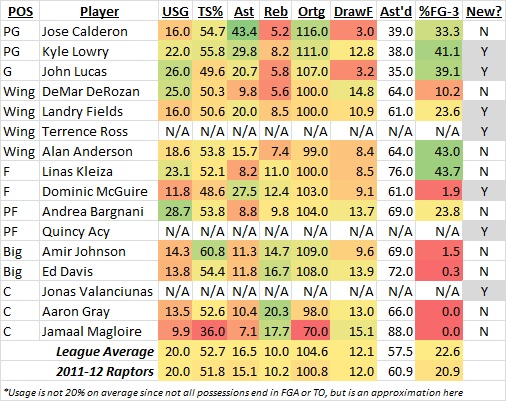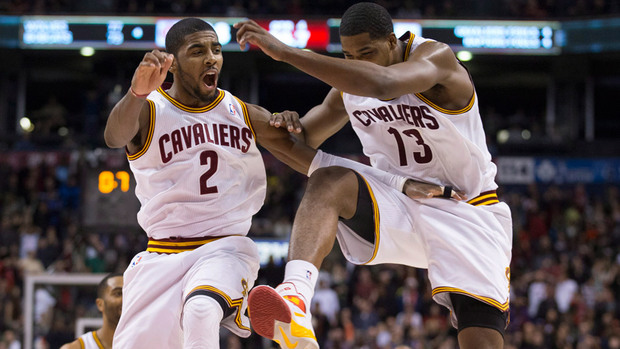Note: This post was updated around 3:30pm on 9/28 due to an error in the data – Usage Rate/40min was originally used instead of Usg% as intended. Also, OffEff from ESPN was changed to ORtg from BR. Heatmapping was changed to reflect league average values. Some analysis has changed to reflect the new data.
The Raptors turned over half of their roster in the offseason, including their new starting point guard, floor general and alpha dog. With the addition of three rookies, two point guards, and two wing players, there’s going to be a whole lot of ‘new’ to get used to during training camp.
I set out to look at some of the offensive statistics of the Raptors and identify areas where they may see improvement, decline, or just change. For example, the Raptors had an above-average percentage of their field goals come assisted last year, but their starting point guard is now someone who has a much lower assist rate than the previous one. In addition, while the Raptors took a below-average proportion of their field goal attempts from long range last year, they added Lowry, Fields and Lucas, who all shoot a healthy amount of threes.
The chart below shows a handful of different stats for the new and carryover Raptors from last season, heatmapped with the league average and the mark of last seasons’ Raptor team.

Kyle Lowry’s Impact / Starters’ Usage
The first thing that becomes obvious is the difference in style between Lowry and Calderon. It’s difficult to get a handle on exactly how the minutes will be distributed at the point, especially with Casey admitting there will be times when two of Lowry, Calderon and Lucas are on the floor together. Still, the difference is important.
The two are different more or less across the board. Lowry uses more possessions, has a much lower assist rate, rebounds more, draws more fouls, and shoots a higher percentage of his shots from long range. While this isn’t to say one style is better than the other, it does at least show us that when both players are on the floor, Lowry will likely play a role closer to that of a two-guard on offense.
For the rest of the starting lineup, there are implications as well. Since Lowry uses more possessions than Calderon, it means there will be fewer possessions for other starters. While Fields has a lower usage rate than last year’s starting small forwards, the team’s total usage percentage is greater than 100 (about 106). With Lowry and Bargnani inarguably the team’s two most potent offensive weapons, it would be difficult to argue that either should see their usage decreased (in fact, you could argue Lowry’s should increase given his new role on the team). Thus, there may be times when Bargnani plays with members of the second unit and is the key initiator on offense then. The argument could also be made that with such a usage-heavy starting unit, Aaron Gray may make sense has a small-minute starter since he commands so few possessions. I’ll discuss the potential impact on DeRozan shortly, but if the starting five is as we seem to be assuming, his usage rate could be the one that takes a hit.
Beyond who starts, Lowry’s lower assist rate will also have an impact on the production of DeRozan, Fields, and Bargnani, who all had a higher than average proportion of their field goals come assisted. Either Lowry will work to assist on more baskets than he traditionally has, or these players will have to work a bit more to get their own shots.
Lowry also draws a lot of fouls, making our assumed starting lineup great at drawing fouls but leaving the bench relatively weak in that regard.
The Rookies
Some of this commentary or the numbers in general may be flawed because we don’t know how Ross and Valanciunas will get involved. We can probably assume that Valanciunas’ offense will come from the pick-and-roll, leading to a high proportion of assisted field goals, and you’d hope his rebounding rates are above par as well.
Meanwhile, Ross’ range of styles and outcomes is much wider, making his role and fit hard to predict. If Ross ends up being a slash-and-shoot threat who can get to the line and hit from long range, he’ll make a great second option on the second unit and a strong complement to Jose and the pick-and-roll bigs. However, if he struggles with range or creating for himself, there will be an enormous burden on Calderon to create all of the non-Kleiza offense, though that’s something he’s pretty accustomed to now.
Big Combos
With Johnson, Davis, Bargnani, Gray, and Valanciunas all likely to split the minutes at power forward and center, it will be interesting to see how Casey pairs up his bigs to maximize their output. For instance, the Raptors like Bargnani and Johnson together because of the defensive implications of having a strong help defender (Amir) with a decent man defender who is poor from the weak side (Bargs), and because of the offensive implications of having a strong offensive rebounder (Amir) with a big who plays further from the basket (Bargs).
This doesn’t necessarily mean they’ll be a tag team with Davis and Valanciunas spelling them, though. Ed is less of a factor offensively than Amir but he does certain things better, like overall rebounding and his ability to draw fouls. Unfortunately, we don’t have evidence on Valanciunas yet to show who he may play best with. It’s my assumption that you’ll see Bargnani play with Johnson, Gray and Valanciunas given his large minutes load, and then you’ll see Davis tag in for backup power forward minutes with whichever center he ends up playing best with (my guess is Valanciunas, since pairing him with Gray takes too much offense off the floor, and pairing him with Johnson leaves the unit a bit small).
Raptors’ Offense
It’s obviously difficult from some stats and scouting reports to guess how the team’s offense will change. Like I’ve mentioned, the difference between Lowry and Calderon is the biggest catalyst for change, but I think the biggest strategic change we’ll see is the Raptors ratcheting up their percentage of field goal attempts from downtown.
With offensive players that tend to do better getting to the line, the 2012-13 Raptors will likely put increased pressure on opposing defenses, freeing up shooters more than last year. In addition, the Raptors have added Fields and Ross as floor stretchers and Valanciunas as a threat as the dive-man off pick-and-rolls, making the offense at once more versatile and dangerous.
In terms of individual roles, I think we’ll know very quickly what kind of work DeRozan has done over the offseason. I’ve basically been working under the assumption, to this point, that DeRozan will have a similar profile to last year, but that’s almost certainly incorrect. If DeRozan hasn’t made significant strides, specifically in terms of efficiency and long-range shooting, it seems likely his role would be diminished in order to get the other wing players and point guards more floor time, as well as to free up possessions in the starting unit. If, however, DeRozan makes the long-expected leap to being a reliable, semi-efficient 20-point man, his development could require Lowry to give up some possessions and relegate Fields to more of a spot-up shooter than any sort of key cog (or move to the bench). I think we’ll know in short order how this particular kink is going to get ironed out, as it has the potential to impact multiple roles in the offense.
Lineups
My assumed starting lineup so far has been Lowry, DeRozan, Fields, Bargnani and Johnson, which I believe to be the general consensus at this point. That would mean the second unit is Calderon, Ross, Kleiza, Davis and Valanciunas with some Lucas and McGuire sprinkled in.
That first unit has been discussed in pretty great detail, but it’s interesting to look at how the numbers stack up – a high usage rate profile; a slightly below-average assist rate but a higher than average percentage of field goals that come from assists (something’s gotta give); a below average rebounding unit; an above average unit at getting to the line; a slightly below average proportion of field goals from long range but an arguably abover-average three-point shooting unit depending on how you feel Fields will bounce back. Either the starters will have to be staggered with the second unit, one high-volume player (DeRozan?) may have to join the reserves, or someone’s usage rate is going to take a hit, and it shouldn’t be Lowry or Bargnani.
As for the second unit, it’s tougher to tell with two rookies in the mix, but the drop in usage rate from Lowry to Calderon, DeRozan to Ross, and Johnson to Davis can be made up in part by the fact that Kleiza commands a lot more possessions (for good or for bad) and Lucas can be utilized with the second unit to improve its ability to create offense, possibly in a Calderon-Lucas-Ross-Davis-Valanciunas combination.
I think, given the usage profiles we’ve identified, I would prefer DeRozan to join the second unit, with Terrence Ross starting. While Ross needs touches to develop, he certainly won’t command as many possessions as DeRozan. In addition, if he is an adequate three-point shooter as expected, he adds a dangerous weapon as a corner-three man to the starting unit, whereas DeRozan’s ability to create his own offense and get to the line is somewhat redundant with Lowry and Bargnani commanding possessions. This could weaken the defense of the second unit a bit, but that’s less of a concern than finding shots for everyone. I don’t think swapping Gray for Johnson is the answer, given how well Johnson and Bargnani complement each other.
What would your preferred units be?




